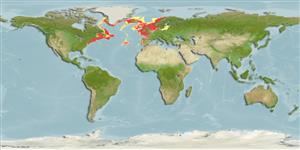Classification / Names
Common names from other countries
Main reference
Size / Weight / Age
Max length : 60.0 cm SL male/unsexed; (Ref. 4705); max. published weight: 2.5 kg (Ref. 35388); max. reported age: 25 years (Ref. 6263)
Length at first maturity
Lm 30.4 range ? - ? cm
Environment
Marine; demersal; oceanodromous (Ref. 51243); depth range 18 - 1570 m (Ref. 5951), usually 45 - 366 m (Ref. 6263)
Climate / Range
Temperate; 2°C - 6°C (Ref. 6263), preferred 6°C (Ref. 107945); 74°N - 35°N, 79°W - 26°E
Distribution
Eastern Atlantic: Northern Spain to northern Norway. Western Atlantic: Gulf of St. Lawrence and Grand Banks in Canada to North Carolina in USA (Ref. 7251).
Countries | FAO areas | Ecosystems | Occurrences | Introductions
Short description
Dorsal
spines
(total): 0;
Dorsal
soft rays
(total): 95-120;
Anal
soft rays: 85 - 102. Pectoral fin of eyed side shorter than head. Distal part of pectoral fin blackish (Ref. 232). Large mucus pores on the blind side of the head. Uniform coloration, rough scales. Body elongated with complete straight lateral line (Ref. 35388).
IUCN Red List Status (Ref. 115185)
Threat to humans
Harmless
Human uses
Fisheries: commercial
Tools
Special reports
Download XML
Internet sources
Estimates of some properties based on models
Phylogenetic diversity index
PD50 = 0.6250 many relatives (e.g. carps) 0.5 - 2.0 few relatives (e.g. lungfishes)
Trophic Level
3.2 ±0.2 se; Based on diet studies.
Resilience
Low, minimum population doubling time 4.5 - 14 years (K=0.15-0.2; tmax=25)
Vulnerability
High to very high vulnerability (68 of 100)
Price category
